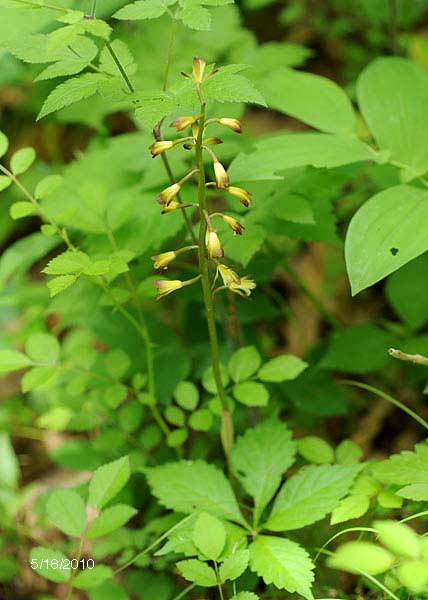
Date: May 18, 2010. Location: Amana Woods (map)
| Classification Hierarchy | |
| Kingdom | Plantae |
| Subkingdom | Tracheophyta |
| Superdivision | Spermatophyta |
| Division | Magnoliophyta |
| Class | Liliopsida |
| Subclass | Liliidae |
| Order | Orchidales |
| Family | Orchidaceae |
| Genus | Aplectrum |
| Species | Aplectrum hyemale |

Date: May 18, 2010. Location: Amana Woods (map)
Scientific Name: Aplectrum hyemale (Aplectrum [Gr] without a spur. plectron = spur). hyemale may be a reference to winter; [L] hiemalis = wintery. The flower lacks a spur and the leaf remains green in winter.
Common Name: Putty root or Adam-and-Eve plant (a fanciful allusion to the bridge of tissue connecting two corms - like Eve developing from Adam's rib).
Origin: Native
Habitat: In shaded areas of mesic woods with rich soils.
Notes: Listed as infrequent to rare in Iowa (Eilers and Roosa P.166), the plants are often in small colonies of connected corm-like tubers. The name Putty root comes from the sticky mucilaginous substance in the tubers. Some corms will produce a single leaf in late summer which lasts through the winter and withers in spring about the time that a single erect scape of flowers is produced. All orchids have a plant fungus relationship called myco-heterotrophy at some stage in their development. The root fungi that form orchid mycorrhiza are typically basidiomycetes. Orchid seeds lack energy reserves and are critically dependent on mycorrhizae for germination.
Additional references: 1, 2, 3, 4, 5, 6, 7, 8, 9, 10, 11, 12, 13, 14, 15 16, 17.
Flowers: April/May a single scape about 18 inches high bears an inflorescence of a dozen or so small flowers each about 1 cm long. The flowers lack spurs and in our area maturing fruits (capsules) and seeds are apparent in July.
Leaves: Elliptic leaves usually 4 to 8 inches long, blue-green with longitudinal white "pinstrips", appear corrugated/pleated. Only one leaf is produced from each corm. The leaves appear in late summer or fall and stand out against the light snows of winter and the brown leaf litter of early spring. After flowering the leaves turn yellow and wither.
Glossary: Botanical Terms pdf